- Prelude
- Editorial
- Manjit Bawa
- Husain's Calcutta
- Vivan's Visionary Reconstruction of History at Victoria Memorial, 1998
- The Remaking of Indian Painting
- Picasso Re-visited
- Benodebehari Mukherjee: A Recluse and the Centenary Show
- In Past and Present Continuum Speaking to Thota Vaikuntam
- The Importance of Being Husain
- Image-making to Image-circulation: Implicated Image(ry)
- 153 Years Old yet Young at Heart: Mumbai's Sir JJ School of Art
- Two Decades: A Critical Insight by an Art Critic and an Artist
- Biedermeier Style: Biedermeier Furniture
- Vacheron Constantin
- The Irony of Andy Warhol
- Then and Now: An Indian Perspective to the Art Market 1990-2010
- Pablo, Andy, Here I Come
- What Happened and What's Forthcoming
- Bid's Got Hammered?
- Anish Kapoor at National Gallery of Modern Art in Delhi and Mehboob Studio in Mumbai
- Tribute to Hemanta Misra: the “Calcutta Group” Painter
- Art Events Kolkata
- Mumbai Art Sighting
- Art Bengaluru
- Exploring the Riverine Culture of Bengal
- Alternative art practices define Bangalore
- India Art Summit Turns Three
- An Aesthetic Fair
- SSVAD: A New Arts Centre in Santineketan
- Visible Invisible by Siraj Saxena
- A Fleeting World : Paintings by Sunil De
- Previews
- In the News
ART news & views
The Importance of Being Husain
Volume: 3 Issue No: 12 Month: 1 Year: 2011
Profile
by K Bikram Singh
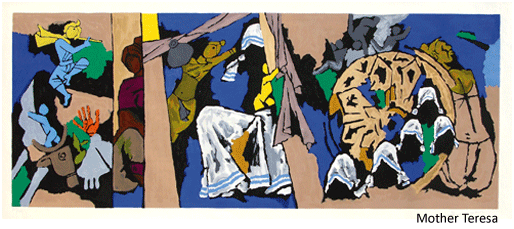
Maqbool Fida Husain, who was persuaded by circumstances to take the citizenship of Qatar early this year, has already become a part of our art history while remaining a strong presence in the contemporary Indian art scene. 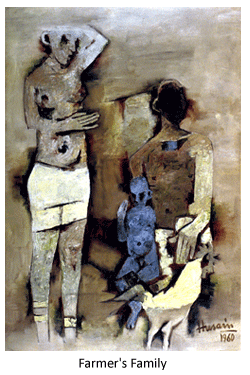 His passage into art history is obviously on account of his long engagement with art spread over at least sixty-seven years. Ironically, his presence in the contemporary Indian art scene is largely because of his forced absence from India. It is this peculiar situation of Husain that makes an evaluation of his work difficult - even for a person like me who had written a detailed book on his work in 2008. It is however clear that no history of modern Indian art can be written without MF Husain, now or later.
His passage into art history is obviously on account of his long engagement with art spread over at least sixty-seven years. Ironically, his presence in the contemporary Indian art scene is largely because of his forced absence from India. It is this peculiar situation of Husain that makes an evaluation of his work difficult - even for a person like me who had written a detailed book on his work in 2008. It is however clear that no history of modern Indian art can be written without MF Husain, now or later.
One of the first things that strikes one while viewing Husain's work is the fact that, except for a very brief period when he studied art in the evening classes at the Indore School of Art, Husain is a self-taught artist who has not stopped learning and experimenting even at the age of 95. When I last met him in London in October 2009 he was modeling an installation made of seven larger than life size glass horses to be cast in Moreno, five iconic cars with their engine sounds mixed with music to be composed by AR Rehman and a panel of painted horses forming a backdrop. This was initially supposed to be installed in Dubai but has now been shifted to Qatar. Husain has never experimented with the glass before. This experiment, therefore, is likely to open another vein in the mine of Husain's talent and may become for him a new departure.
Given his insatiable appetite to learn new things, Husain's art production has passed through a variety of stages. 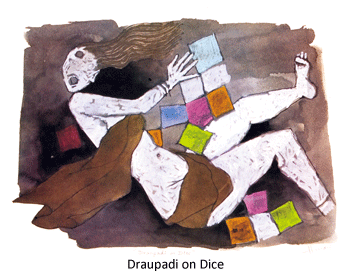 For example, his earliest existing painting is a water colour portrait of Bismillah Bi, his friend Abdul Wahid's mother, which he had made in 1939 in Indore during a visit from Bombay where he was working as a hoarding painter. This is like a posed studio photograph that bears no resemblance to the mature work of Husain. Incidentally, this painting is still available in Indore. By 1947, when he painted Kumhar or The Potters his work had dramatically changed. This is the work that Francis Newton Souza had noticed in the Bombay Art Society's annual exhibition that prompted him to invite Husain to join the Progressive Artists' Group in 1948. Unfortunately, only a black & white image of this work now survives.
For example, his earliest existing painting is a water colour portrait of Bismillah Bi, his friend Abdul Wahid's mother, which he had made in 1939 in Indore during a visit from Bombay where he was working as a hoarding painter. This is like a posed studio photograph that bears no resemblance to the mature work of Husain. Incidentally, this painting is still available in Indore. By 1947, when he painted Kumhar or The Potters his work had dramatically changed. This is the work that Francis Newton Souza had noticed in the Bombay Art Society's annual exhibition that prompted him to invite Husain to join the Progressive Artists' Group in 1948. Unfortunately, only a black & white image of this work now survives.
Kumhar introduces the common Indian man in the world of modern Indian painting. It is, of course, true that the Santhals, who were essentially common peasants, frequently appeared in the paintings of Nandalal Bose. However, these Santhals were somewhat idealized though not heroic in the tradition of socialist realism. The common man again makes a strong appearance in the works of Gobardhan Ash (now practically forgotten outside West Bengal) and the prints of Chittoprasad. 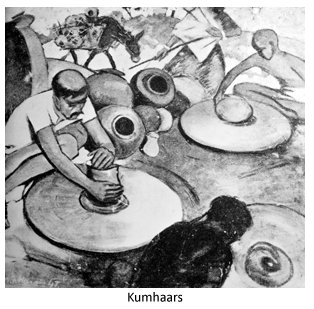 Here again generally the common man appeared as a starving and famished human being. In Husain's Kumhar and also in his later paintings, the common man and woman appear with their ordinary dignity without any need for ornamentation or idealization somewhat like Satyajit Ray's characters in Pather Panchali. The finest example of celebrating the dignity of common rural Indian in Husain's work is the Farmer's Family in oil on canvas done in 1960.
Here again generally the common man appeared as a starving and famished human being. In Husain's Kumhar and also in his later paintings, the common man and woman appear with their ordinary dignity without any need for ornamentation or idealization somewhat like Satyajit Ray's characters in Pather Panchali. The finest example of celebrating the dignity of common rural Indian in Husain's work is the Farmer's Family in oil on canvas done in 1960.
It bears emphasis that following political independence, the Indian society was fast changing. Industrialization and urbanization had picked up pace from about 1962 onwards following the Indo-Chinese conflict but Husain's common man remains largely a rural or a small town man. He does not touch the working class man. It is Sudhir Patwardhan who introduces working class aesthetic in modern Indian painting, several decades later. This, of course, does not lessen the achievement of Husain because by the time the Indian working class had made as strong a presence on the Indian scene as the Indian peasantry, Husain had moved on from the social world of the ordinary man to his mythological world. After all, art is not merely a mirror of its times. It also adds a new dimension to the times.
Husain's interest in the common Indian man led him to exploring Indian mythology on the advice of Dr. Ram Manohar Lohia who advised Husain to stop painting for Tatas and Birlas and start painting for the common man. “Paint Ramayana.” he said. Mythology is not just myth; it is also collective memory and collective fantasy. 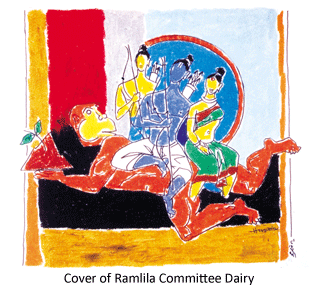 It is relevant here to recall that Husain has spent crucial years of growing up in the Indore of 1920's and 1930's. Indore was then socially feudal but culturally progressive with a strong presence of versification in Urdu and classical Indian music and dance. In the matters of art, the Holkar kings were aware of International art trends and one of them i.e. Yashwant Rao Holkar-II had even acquired a sculpture of Constantin Brancusi. Holkar Royals patronized the Muharram procession with as much enthusiasm as the Ramlila celebrations. Husain therefore considered both the Ramayana and the Quran as part of his Indian heritage.
It is relevant here to recall that Husain has spent crucial years of growing up in the Indore of 1920's and 1930's. Indore was then socially feudal but culturally progressive with a strong presence of versification in Urdu and classical Indian music and dance. In the matters of art, the Holkar kings were aware of International art trends and one of them i.e. Yashwant Rao Holkar-II had even acquired a sculpture of Constantin Brancusi. Holkar Royals patronized the Muharram procession with as much enthusiasm as the Ramlila celebrations. Husain therefore considered both the Ramayana and the Quran as part of his Indian heritage.
It is this attitude of common heritage that makes Husain's Ramayana and Mahabharata series along with paintings inspired by Islam, a grand celebration of the multi-cultural identity of India. Nor is his interest confined only to Hinduism and Islam. He has also explored the world of Jainism, Buddhism, Zoroastrianism and Christianity. Husain's artistic explorations of different mythologies are neither illustrative, ritualistic nor exclusivist. Quite often their worlds metamorphose into each other. For example, in one of the paintings Mother Teresa becomes Yashodha, the true mother of Krishna because it is she who had brought him up and therefore represents the ideal of motherhood like Mother Teresa.
I can understand why the RSS and its political associates are vexed by Husain's Hindu mythological paintings. Husain's work challenges this attempt to paint India into a single-religion-with-a-single-interpretation society instead of a multi-religious-with-multi-interpretations society that has continuously absorbed alien cultures in its long history. It is true that Husain does suffer from a sense of humour and child like mischief as in Draupadi on Dice, an acrylic on paper work of 1971. 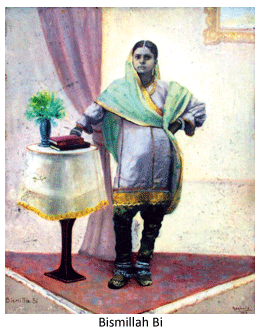 This painting with the image of a frightened woman falling on a dice board can be considered at odds with the desired contemporary attitude towards women. Such isolated works can at best be called debatable. Such isolated works can at best be called debatable and as Umberto Eco points out in a democratic society debatable art and literature must remain open to debate. These should not be placed beyond debate by legal or social censorship.
This painting with the image of a frightened woman falling on a dice board can be considered at odds with the desired contemporary attitude towards women. Such isolated works can at best be called debatable. Such isolated works can at best be called debatable and as Umberto Eco points out in a democratic society debatable art and literature must remain open to debate. These should not be placed beyond debate by legal or social censorship.
Lastly, one of the most important achievements of Maqbool Fida Husain's art is that it has liberated modern art from the confines of elitism and has made its language accessible to the lay person. Husain's art, like Kabir's poetry, has repeatedly asserted that you can be direct and simple without being superficial. The great mystery of Husain's art is that while it immediately attracts you on first viewing, it continues to invite you to see it again and again and discover new meanings.